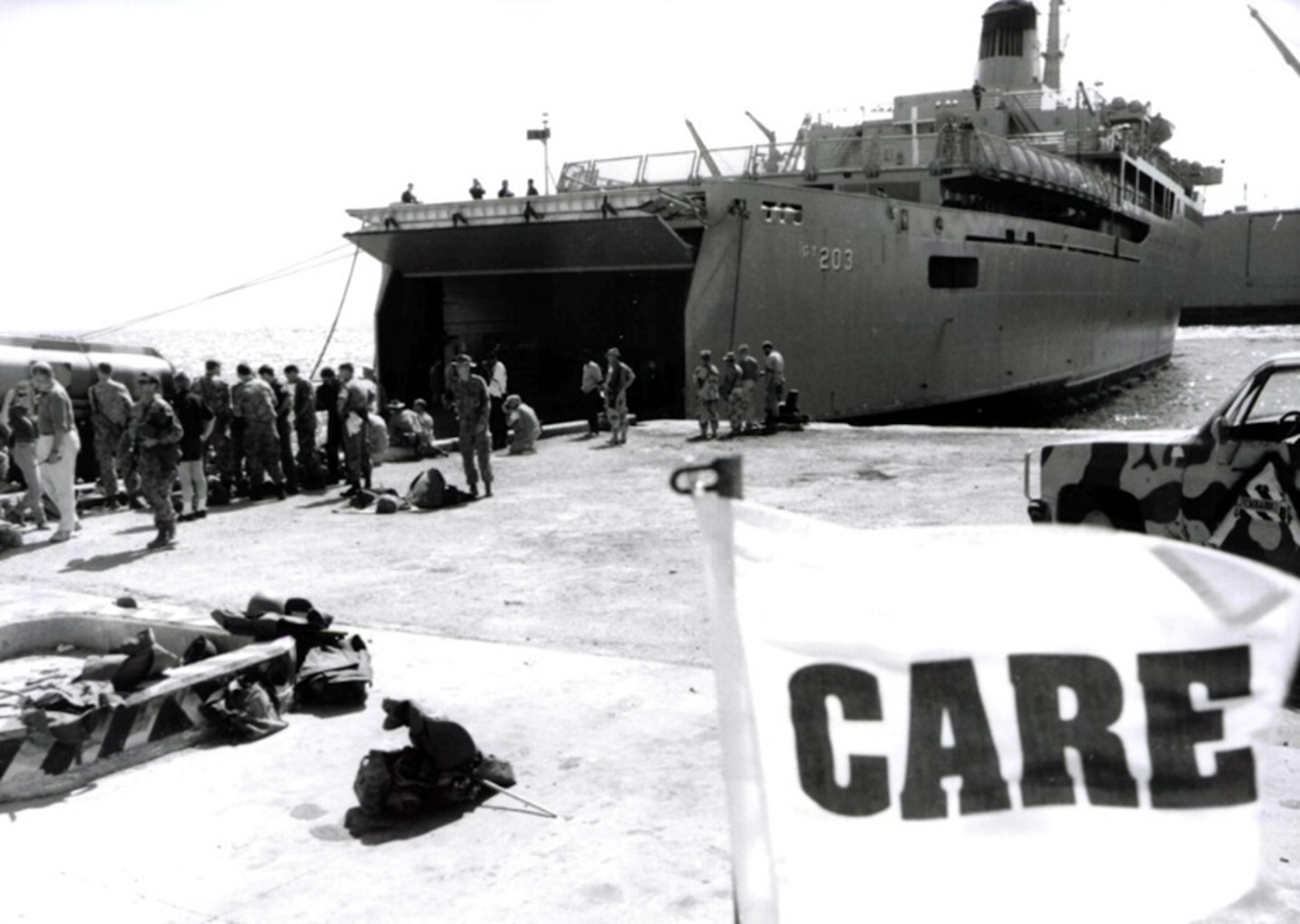Thirty years after the event, HMAS Tobruk and the crew members of her 1992-93 Operation SOLACE deployment to Somalia received approval from the Minister for Defence Personnel, Matt Keogh for the award of a Meritorious Unit Citation. This followed a review of operational service and a recommendation by the Defence Honours and Awards Tribunal into the joint ADF operation involving more than 1,200 ADF personnel.
Background
In 1992, Somalia was beset by famine and civil conflict. Central authority had collapsed and armed groups were preventing the delivery of humanitarian aid to a starving population. The initial international response was a small United Nations (UN) technical team dispatched to Somalia’s capital Mogadishu in March and April 1992 to plan for ceasefire monitoring and the delivery of humanitarian aid.
The UN Mission rapidly expanded due to the level of lawlessness and lack of security throughout the country which included the presence of armed gangs looting supplies, attacking incoming aircraft and ships, and preventing the delivery of humanitarian aid.
The role of security personnel in the United Nations Assistance Mission in Somalia (UNOSOM) was to protect and secure UN personnel, equipment at airports and seaports and to escort humanitarian supplies to distribution centres in the city and surrounding areas. The total strength grew to 4,219 personnel in order to help mitigate widespread starvation in the areas seriously affected by the civil war and drought.
Operation Solace
Operating in parallel with UNOSOM was the United States led Unified Task Force (UNITAF). The goal being to protect the delivery of humanitarian aid and restore peace. The Australian contribution to UNITAF included naval vessels and a battalion group of over 1,200 people. The Australian contingent codenamed ‘Operation Solace’, included:
- 1 Royal Australian Regiment Group (1RAR Gp, 990 people, Australian Army)
- 1st Battalion, Royal Australian Regiment (1RAR)
- B Squadron, 3rd/4th Cavalry regiment
- selected components of the regular army
- HMA Ships Jervis Bay and Tobruk with 817 Squadron Fleet Air Arm (220 people, Royal Australian Navy)
- Royal Australian Air Force logistical support.
HMAS Tobruk
On 9 December 1992 HMAS Tobruk was notified that she may be required to deploy to Somalia in support of United Nations Security Council resolution 794. After confirmation on 15 December crew members were recalled from Christmas leave and Tobruk put to sea on 22 December. A short work up followed and a Sea King helicopter embarked. En route to Townsville she was informed that the ship would be required to remain on station in Somalia for the duration of the operation.
On 29 December in Townsville she commenced embarking personnel, vehicles and equipment from 1RAR and departed for Somalia on 31 December. Tobruk arrived off Mogadishu on 19 January 1993 after visits to Darwin and Diego Garcia. She entered the port the following day and immediately began unloading, returning to anchor at sunrise on 21 January.

Once secured, the port of Mogadishu proved pivotal to coalition operations and the delivery of humanitarian aid to Somalia. (DJ Perryman)
Tobruk remained in African waters for the next four months providing logistic support and hotel services to ground forces in Mogadishu and conducting exercises with other units of the Multi-National Force. She also provided training for US Marines and Navy Seals in merchant ship boarding techniques and made occasional port visits to Mombasa to embark equipment and other stores, and to undertake maintenance. Tobruk also visited Port Victoria in the Seychelles in late April. She began the backloading for return to Australia in May and on 20 May with vehicles, stores and 1RAR soldiers embarked departed Mogadishu for home in company with HMAS Jervis Bay. She arrived in Sydney on 21 June 1993.
HMAS Jervis Bay
HMAS Jervis Bay departed Sydney on 19 December 1992 for Mogadishu to provide strategic sea-lift for Operation SOLACE. Her operations, in concert with those of HMAS Tobruk, amounted to Australia’s largest military sea-lift operation since the end of the Vietnam War.
Jervis Bay arrived in Townsville on 22 December where she embarked a detachment of troops from 1RAR and some 800 tonnes of cargo bound for Mogadishu. She entered the SOLACE Area of Operations on 12 January 1993 having refuelled at Darwin and Diego Garcia en route. On arrival Jervis Bay was assigned an anchorage some five and half miles from the port due to the large amount of shipping in the area. Ships from the navies of the USA, Canada, India, France, Turkey and Spain were present while port operations were controlled by US Marines. She was allowed into the port two days later to disembark her troops and cargo. Jervis Bay’s Commanding Officer, Commander Errol Morgan, RAN later related the scene that evening: “The darkened city of Mogadishu, little more than a collection of remains with all buildings stripped of rooves, windows and fittings, took on an eerie appearance at night. Sporadic gun fire was clearly audible/visible in the near vicinity but fortunately no action was directed against Jervis Bay”.

She departed Mogadishu the following day rendezvousing with Tobruk on 17 January to provide Tobruk’s command team with a comprehensive brief on the situation in Mogadishu. She reverted to her role as a training ship when she arrived in Diego Garcia on 21 January.
Jervis Bay deployed to Somalia for a second time in May 1993 arriving in Mogadishu on the 17 May where she embarked troops and equipment for passage back home to Australia. She departed Mogadishu three days later in company with Tobruk arriving in Townsville on 16 June.

References:
Defence Media Release, Meritorious recognition for veterans who served in Somalia, 18 April 2023 available at, https://www.minister.defence.gov.au/media-releases/2023-04-18/meritorious-recognition-veterans-who-served-somalia
Defence Honours and Awards Tribunal’s report available at, https://defence-honours-tribunal.gov.au/inquiries/
DVA Anzac Portal, Australians in the UN missions to Somalia 1992 to 1995, available at, https://anzacportal.dva.gov.au/wars-and-missions/peacekeeping/operation-summaries/somalia-1992-1995#1
Sea Power Centre – Australia, HMAS Tobruk (II) History, available at, https://www.navy.gov.au/hmas-tobruk-ii
Sea Power Centre – Australia, HMAS Jervis Bay (I) History, available at, https://www.navy.gov.au/hmas-jervis-bay-i




